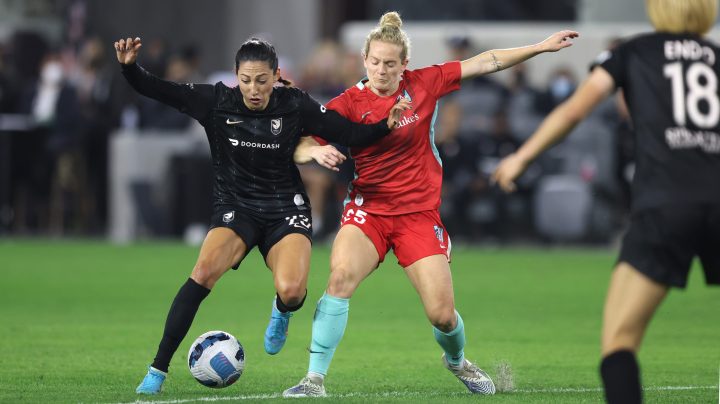
High rates of injury in women’s soccer may be due to lack of funding
High rates of injury in women’s soccer may be due to lack of funding

Last June, Racing Louisville took on Angel City FC in a regular season game of the National Women’s Soccer League. Louisville was up 1-0 in the first half when Angel City forward Christen Press got a long pass from down the field. She raced with the ball toward the goal, shot and scored. The game was tied.
But in the second half, Press took the game’s spotlight for a different reason. With Angel City up 2-1, Press lost the ball to a Louisville player, turned to chase, but immediately collapsed to the ground. A few minutes later, she limped off the field. Two days later, she announced that she’d torn the anterior cruciate ligament, or ACL, in her right knee. Now, over a year later, the injury has kept the 34-year-old out of the World Cup, currently underway in Australia and New Zealand.
A World Cup is always the biggest stage for professional soccer players. But some top stars like Press, along with players for England, France, Zambia, the Netherlands, New Zealand and Canada, are all missing for the same reason: injuries to their ACL.
Tearing an ACL can keep a player off the field for months, even a year or more. It’s nearly three times as common among women, according to the National Institutes of Health. And it’s just one of the injuries –- and other physical issues –- that women’s soccer players face more often than men. Closing that gap will require investments of time and money.
Women players more frequently tear ACLs for several reasons. First, there are physiological factors, including hormonal fluctuations, according to Dr. Elizabeth Gardner, an associate professor of orthopedic surgery at Yale, and the head physician for Yale athletics.
“It has been repeatedly now shown that there is an increase in risk in ACL injuries in the few days leading up to ovulation,” Gardner said.
Anatomy plays a role too, she said. Women typically have wider pelvises than men and more flexibility in their hips and knees. That puts more stress on the knee. But those physical differences don’t make knee injuries inevitable. There are exercises designed specifically to help women prevent ACL injuries “which work to improve what are called the neuromuscular signals, how the brain is sending the signals and moving the body,” Gardner explained.
There’s evidence that if players start that training when they’re in their teens, their risk of ACL injury can decrease. But are those programs being used enough?
“I think the numbers show us that they’re not,” Gardner said.
High rates of ACL tears, and a lack of sufficient training to prevent them, are just one example of the ways in which the women’s game is under-resourced, said Ann Pegoraro, a professor of sport management at the University of Guelph in Ontario.
“We’ve focused a lot on pay equity and salaries,” Pegoraro said. “What we really need in terms of equity is across the entire investment in the athlete, in the team, from training all the way through to competition.”
Investment is needed in equipment, too. Most importantly, cleats — known in soccer as boots.
“The boots on the market today are engineered for a white male,” said Claire Bloomfield, the head of women’s football at the European Club Association, which represents professional teams across the continent.
The ECA funded a study this year that surveyed several hundred players about their boot fit. Over 80 percent reported some level of discomfort.
“It really is just jaw dropping that we’re professionalizing women’s football in the way that we are, but the most important piece of kit a player has when she crosses that white line is her football boots, and they’re still not engineered specifically for her needs,” Bloomfield said.
Black, Asian and mixed race players reported even higher levels of discomfort, according to the study. And about 20% of surveyed players said they customize their boots — even cutting holes in the heel — to make them more comfortable.
Just about every aspect of the women’s game needs more investment, said Ann Pegoraro at the University of Guelph.
“They’re not playing on the best surfaces, they’re not having the same support in terms of training facilities, training programs, training personnel, rehab personnel,” Pegoraro said.
“All of the things that you would see surrounding a men’s professional team aren’t there for the women.”
This year’s World Cup could create an opportunity to change that. But it’ll be up to the sport’s leaders, who are mostly men, to decide how much of the money this tournament brings in goes towards keeping more women healthy and on the field.
There’s a lot happening in the world. Through it all, Marketplace is here for you.
You rely on Marketplace to break down the world’s events and tell you how it affects you in a fact-based, approachable way. We rely on your financial support to keep making that possible.
Your donation today powers the independent journalism that you rely on. For just $5/month, you can help sustain Marketplace so we can keep reporting on the things that matter to you.

















